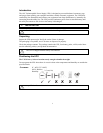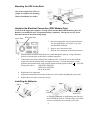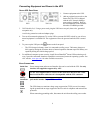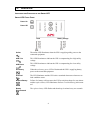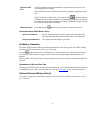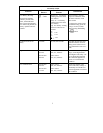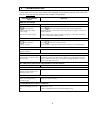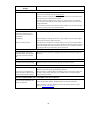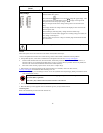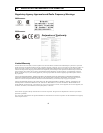
10
PROBLEM AND POSSIBLE
CAUSE
S
OLUTION
THE OVERLOAD LED IS ILLUMINATED AND THE UPS EMITS A SUSTAINED ALARM TONE
The UPS is overloaded. The connected equipment exceeds the specified “maximum load” as defined in
Specifications at the APC web site, www.apc.com
.
The alarm remains on until the overload is removed. Disconnect nonessential equip-
ment from the UPS to eliminate the overload.
The UPS continues to supply power as long as it is online and the circuit breaker
does not trip; the UPS will not provide power from batteries in the event of a utility
voltage interruption.
If a continuous overload occurs while the UPS is on battery, the unit turns off output
in order to protect the UPS from possible damage.
THE REPLACE BATTERY LED IS ILLUMINATED
Replace Battery LED flashes and
short beep is emitted every two
seconds to indicate the battery is
disconnected.
Check that the battery connectors are fully engaged.
Weak battery. Allow the battery to recharge for 24 hours. Then, perform a self-test. If the problem
persists after recharging, replace the battery.
Failure of a battery self-test. The UPS emits short beeps for one minute and the replace battery LED illuminates.
The UPS repeats the alarm every five hours. Perform the self-test procedure after the
battery has charged for 24 hours to confirm the replace battery condition. The alarm
stops and the LED clears if the battery passes the self-test.
THE INPUT CIRCUIT BREAKER TRIPS (208V MODELS ONLY)
The toggle handle on the circuit
breaker (located to the right of the
input cable connection) switches
off.
Reduce the load on the UPS by unplugging equipment and resetting the toggle han-
dle to ON.
AVR BOOST OR AVR TRIM LEDS ILLUMINATE
Your system is experiencing exces-
sive periods of low or high voltage.
Have qualified service personnel check your facility for electrical problems. If the
problem continues, contact the utility company for further assistance.
UPS OPERATES ON BATTERY ALTHOUGH NORMAL LINE VOLTAGE EXISTS
UPS input circuit breaker tripped. Reduce the load on the UPS by unplugging equipment and resetting the circuit
breaker (on the back of UPS) by pressing the plunger in.
Very high, low, or distorted line
voltage. Inexpensive fuel powered
generators can distort the voltage.
Move the UPS to a different outlet on a different circuit. Test the input voltage with
the utility voltage display (see below). If acceptable to the connected equipment,
reduce the UPS sensitivity.
BATTERY CHARGE AND BATTERY LOAD LEDS FLASH SIMULTANEOUSLY
The internal temperature of the UPS
has exceeded the allowable thresh-
old for safe operation.
Check that the room temperature is within the specified limits for operation.
Check that the UPS is properly installed allowing for adequate ventilation.
Allow the UPS to cool down. Restart the UPS. If the problem continues contact
APC at, www.apc.com/supoport
.





